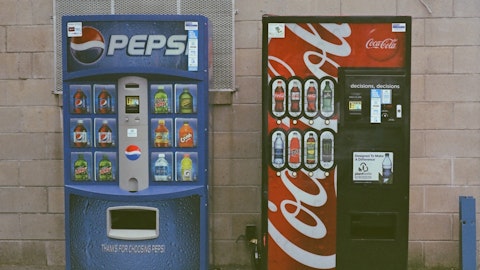Farmer Bros. Co. (NASDAQ:FARM) Q2 2023 Earnings Call Transcript February 8, 2023
Operator: Good afternoon, and welcome to the Farmer Bros. Fiscal Second Quarter 2023 Earnings Conference Call. As a reminder, this call is being recorded. Joining me today are Deverl Maserang, President and Chief Executive Officer; and Scott Drake, Chief Financial Officer. Earlier today, the company issued its inaugural quarterly shareholder letter, which is available on the Investor Relations section of Farmer Bros.’ website at www.farmerbros.com. The shareholder letter is also included as an exhibit to the company’s Form 8-K and is available on the company’s website and on the Securities and Exchange Commission’s website at www.sec.gov. A replay of this audio-only webcast will be available approximately two hours after the conclusion of this call.
The link to the audio replay will also be available on the company’s website. Before we begin the call, please note that all of the financial information presented is unaudited and that various remarks made by management during this call about the company’s future expectations, plans and prospects may constitute forward-looking statements for purposes of the Safe Harbor provisions under the federal securities laws and regulation. These forward-looking statements represent the company’s views only as of today and should not be relied upon as representing the company’s views as of any subsequent date. Results could differ materially from those forward-looking statements. Additional information on factors that could cause actual results and other events to differ materially from those forward-looking statements is available in the company’s shareholder letter and public filings.
On today’s call, management will also reference certain non-GAAP financial measures, including adjusted EBITDA and adjusted EBITDA margin in assessing the company’s operating performance. Reconciliation of these non-GAAP financial measures to their most directly comparable GAAP measures is also included in the company’s shareholder letter. I will now turn the call over to Deverl. Deverl, please go ahead.
Deverl Maserang: Good afternoon, and thank you for joining us. As you saw today, we have now moved our quarterly reporting to a shareholder letter format. This approach better enables us to provide our investors with context around our performance, strategy and progress. If you haven’t had a chance to view it, it can be found on our IR website. So with that, on the call today, I will provide some highlights from the quarter, and Scott will go into a bit more detail on the financials, and then we will field some questions. Looking at our results for the fiscal second quarter, we reported sales growth of 12%, paired with a slight sequential increase in our gross margin. We are finally beginning to see the benefit of contracted price increases and overall customer demand across our national account and DSD businesses.

Photo by Moritz Knöringer on Unsplash
We have more work to do here, but have already seen additional progress early in calendar 2023. Additionally, we improved adjusted EBITDA as we held operating costs in check despite inflationary pressures. We also believe that fiscal Q2 will prove to be the high watermark for our coffee input cost. While we’re encouraged with the early progress, we recognize that our results need to improve from here to achieve the performance, our turnaround work has laid the groundwork for. We think the right factors are in place to see that improvement. The short-term pricing headwinds we have faced more recently are expected to alleviate. Our turnaround has improved our underlying operating cost structure and our strategic growth initiatives, while in the very early stage, are progressing nicely.
This gives us confidence in a more pronounced recovery in sales and margins in the second half of our fiscal year, helped by a much more favorable cost environment. We remain vigilant as we manage through the near term and our vision of a path for long-term profitable growth remains steadfast. I will now turn it to Scott. Scott?
Scott Drake: Thanks, Deverl. Let’s dive right in. Net sales in the second quarter of fiscal 2023 were $132.7 million, up 12% year-over-year. Growth in sales primarily reflects traction with new customers and higher per pound pricing in both our DSD and direct ship sales. This was partially offset by lower volume, which was primarily due to the loss of a large customer at one of our major national accounts in our direct ship sales channel. Gross margin was 22.9% in Q2, which was an incremental improvement on a quarter-over-quarter basis. Margins in the quarter reflect what we believe were peak coffee costs, combined with the previously noted lag that accompanies our contractual cost plus pricing agreements in the direct ship sales channel.
We expect margins to improve further over the next two to three quarters. Adjusted EBITDA loss was $3.1 million in the quarter, an improvement over the last quarter from a loss of $4.9 million. The adjusted EBITDA margin also improved quarter-over-quarter by 170 basis points. Our unrestricted cash balance increased by $7.8 million to $17.6 million as of the end of the calendar year. The increase in unrestricted cash was due to a decrease in working capital, net proceeds from the sale of branch assets and net borrowings under our credit facilities. Turning to direct ship and DSD, we saw a low double-digit percentage sales growth in our direct ship business on a year-over-year basis as we began to see pricing realization after a lag period that depressed the first quarter of fiscal 2023 performance.
On the volume front, 1 of our large national accounts experienced the loss of a major customer, which led to a decrease in our pound volume compared to the prior year period. Looking ahead, we expect that the direct ship business continues to improve. We saw positive momentum in our DSD business as revenue was up in the low double-digit percentage range, driven by our pricing increases. Although volume decreased in the quarter compared to last year, there was strong unit and pricing momentum in December that carried over to January, and we expect continued progress on pricing actions in the coming quarters. Looking ahead, our focus in the coming quarters remains on completing the final elements of our turnaround, driving process improvements that will result in sustainable higher levels of performance and executing on our exciting growth initiatives, including SHOT and Revive that bring more services and products to customers and leverage our national distribution footprint.
In recent weeks, we have started seeing the benefit of our ongoing pricing efforts as these take effect across our direct ship and DSD customers. This development, paired with our falling coffee prices, leave us optimistic that gross margins will recover towards prior year levels exiting our 2023 fiscal year in June. At the same time, current economic headwinds are placing pressure on talent acquisition and wages as well as transportation and other operations. We continue to move aggressively to contain and manage these pressures and we fundamentally believe our cost structure is better positioned than it has been in years to drive better performance as macro conditions abate. Our near-term objectives are to bring Farmer Bros. back to profitability, improve our competitive position for sustainable long-term growth and enhance our ability to manage macroeconomic challenges and challenges within our industry.
We will now open it up for questions. Operator?
See also 12 NASDAQ Penny Stocks Under 10 Cents and 10 Most Advanced Countries in Battery Technology.
Q&A Session
Follow Farmer Brothers Co
Follow Farmer Brothers Co
Operator: Thank you. We will now begin the question-and-answer session. Our first question comes from Gerry Sweeney with ROTH MKM. Please go ahead.
Gerry Sweeney: Good afternoon Deverl and Scott. Thanks for taking my call.
Deverl Maserang: Hi, Gerry.
Scott Drake: Hi, Gerry.
Gerry Sweeney: I wanted to talk about prices pricing. I know you talked a little bit about it there in the prepared remarks. But I think one of the things we discussed in the past was, especially on the DSD side was not just instituting price increases but making sure that they were appropriately or fully pushed through at the street level and maintained at the street level. And I think it’s really two questions. One, how is that going? And two, I believe some of your IT initiatives were being put in place to help also facilitate that I wanted to see if we could get an update on that front.
Scott Drake: Yes. Yes, you bet, Gerry. When we think of pricing, obviously the direct ship is the more straightforward one and you didn’t ask, but we’ll get that out of the way. It’s that pricing agreement we have with all those customers. So it’s kind of a cost-plus pass-through. So there’s that lag in that direct ship side of the business that we’ve talked about. Specific to DSD, and maybe it’s a little bit on us that we haven’t impacted this a little more fully. But you’re right. We continue to see inflationary costs in the business that we have to pass through. So we’re doing so. But even in our DSD business, a lot of our larger national DSD customers are under a pricing agreement as well. And so we have several of these that have windows of execution for changes to the contract, including pricing.
And for example, we’ve been doing those changes that some of those contractual changes for those larger customers, they’ve been happening in November, December, there’s some still in January, February as well. So that’s one we’ll continue to see momentum on that front in regards to the pricing. But the good news is that we think we’ve seen the peak pricing or peak cost for coffee as well as other costs are starting to plateau as well. So we think we’re going to get both momentum on the pricing side and start to see some relief on the cost of goods side and the two of those will combine for the stronger margins that we expect to see in the coming quarters. Regarding the long-term solve, which is I think what you’re getting at with the IT solution, you’re exactly right.
And the IT solution may take a little longer as we work through it, but we’re currently underway with a basically a reengineering of our pricing function for DSD. Taking out some of the complexity, taking out, quite honestly, some of those variables that we have less control over that we’ve talked about. And we’re going to be testing and rolling out this new pricing engine for DSD here over the next two quarters. So by the end of the fiscal year, we think we’ll have substantially improved pricing for DSD and better insights, better controls, all those things. So we think that’s another reason for our bullishness on margins and sales for the coming quarters.
Gerry Sweeney: Got you. Would you be able to quantify or qualify where you are on your pricing versus where you would like to be or should be or however you would phrase that in aggregate, I guess?
Scott Drake: Right. Right. Yes, I think you’re right. I think in aggregate, I would call it middle innings, moving towards the latter stages of the game, but still in the middle innings, unfortunately. One of the things we really want to address with these new engines and our new logic is wherever we can move more swiftly, we want to be able to do so. So that’s one of the things we’re really targeting with some of these improvements.





